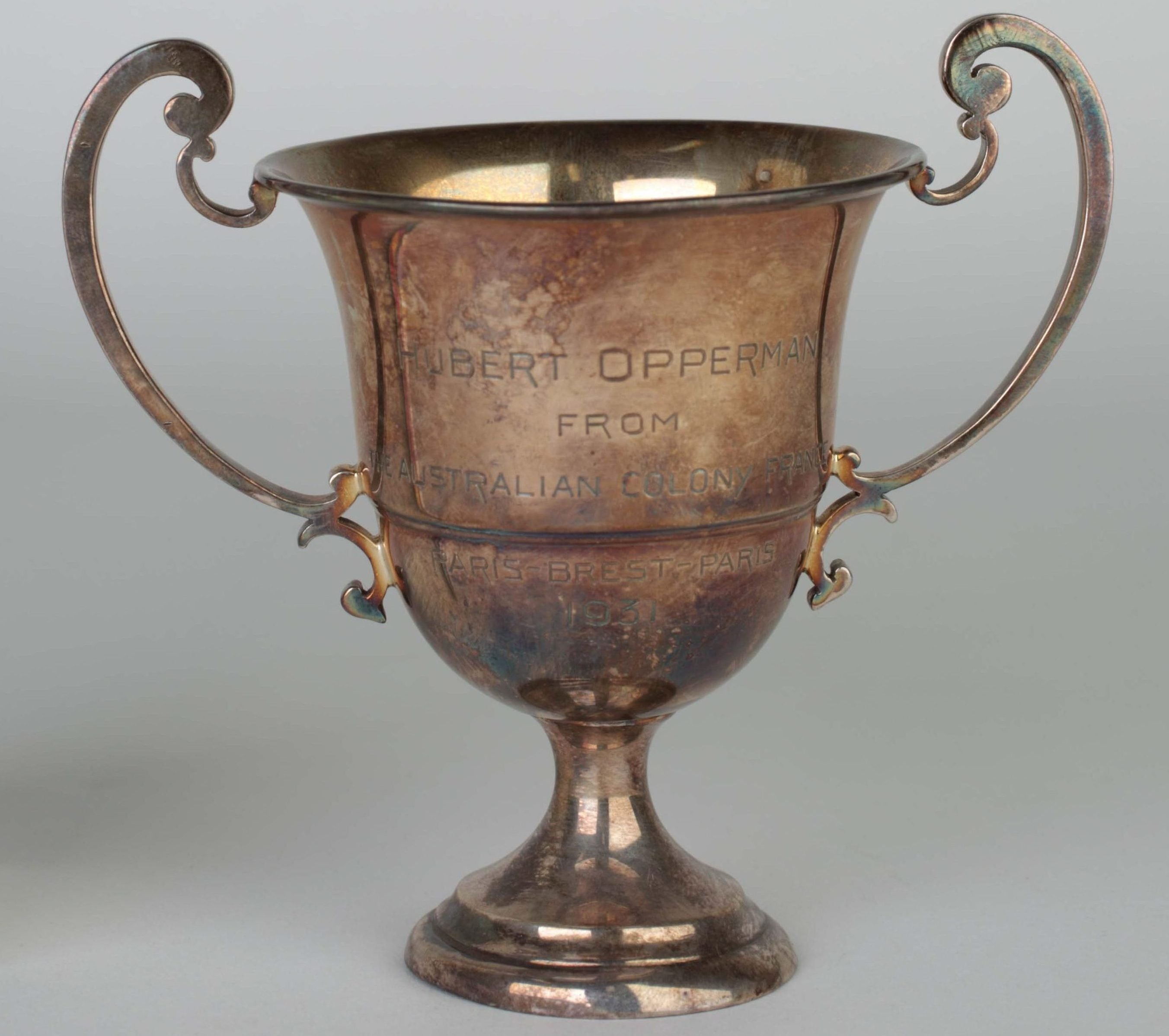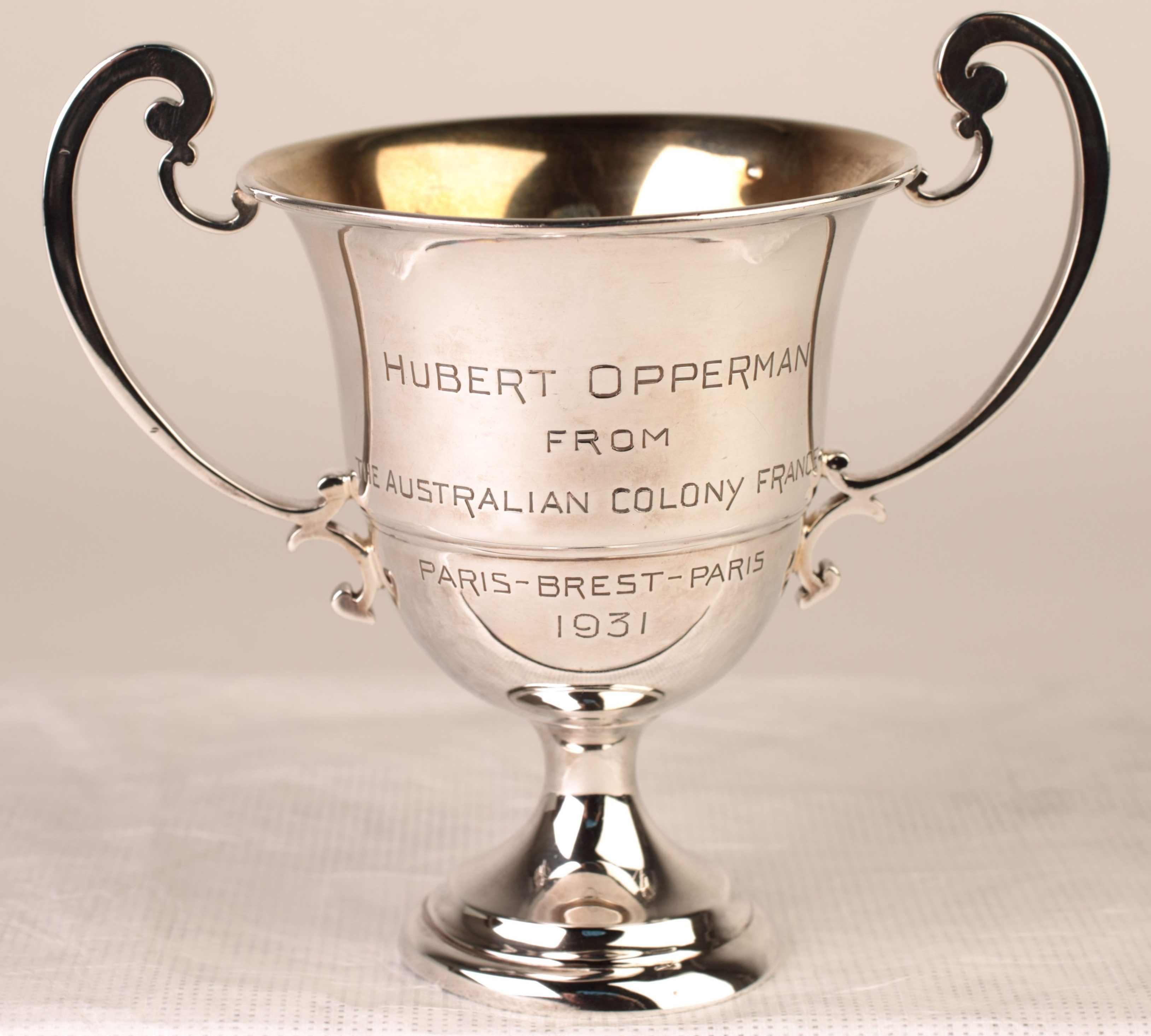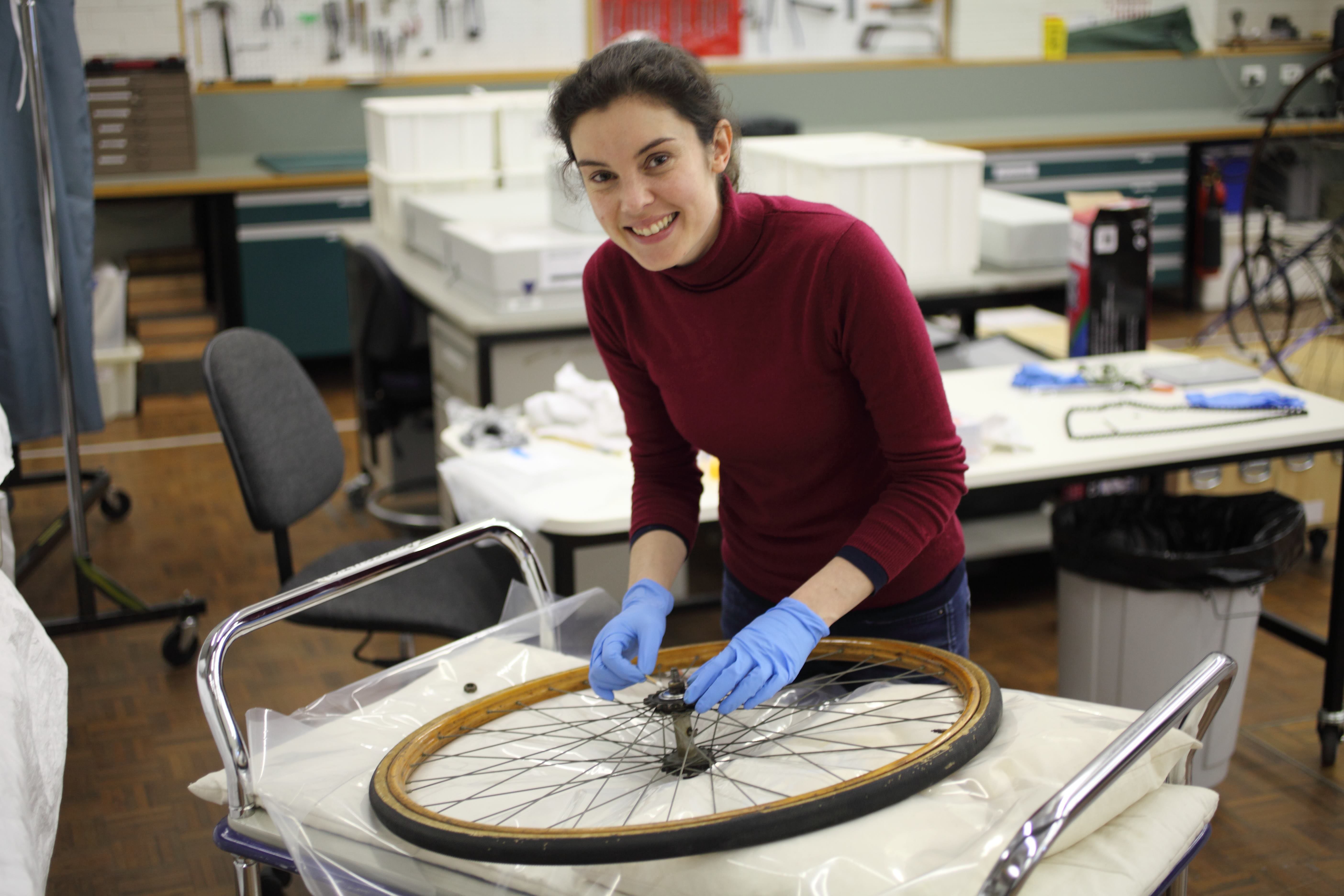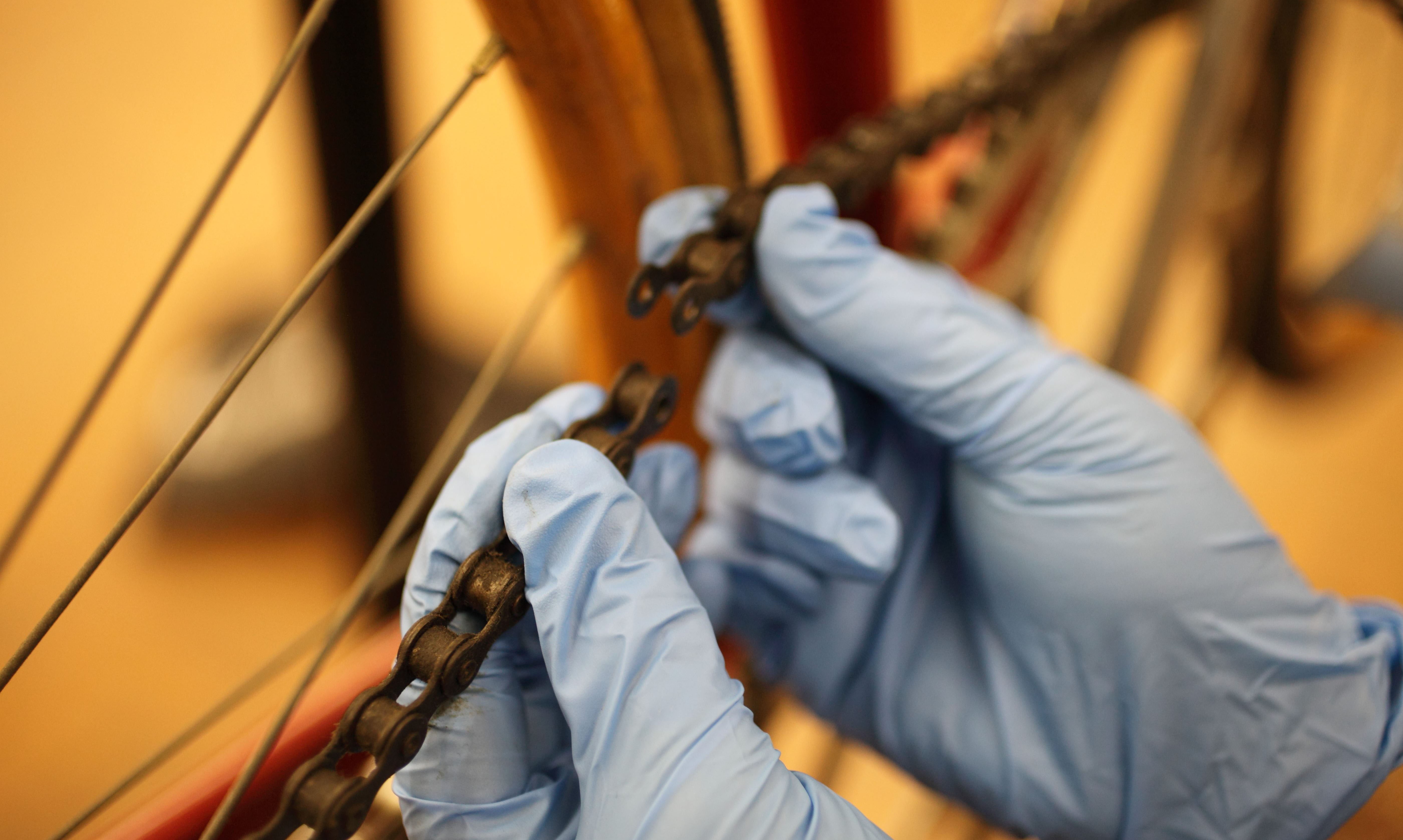Cheering echoed throughout the streets of Sydney in November 1937 as some 60,000 people gathered along the last 80 kilometres of Hubert Opperman’s epic trans-continental ride. Opperman, exhausted, was met by a chaotic and excited crowd exactly 13 days, ten hours and 11 minutes after he began his ride in Fremantle, Western Australia. Police sirens heralded a convoy of hundreds of cars and cyclists. Officials were unsuccessful in their calls for calm but urged the wildly enthusiastic supporters to, at the very least, refrain from slapping Opperman on the back: he was severely sunburned. All over Australia, people tuned into the event via live radio broadcast.

Fans awaiting the arrival of Hubert Opperman at the completion of his trans-continental ride, 1937, outside Malvern Star showroom, Campbell Street, Sydney, MS 10640
Hubert Opperman or ‘Oppy’ as he was affectionately known, was once as famous as cricketer Don Bradman or racehorse Phar Lap. He competed in endurance events across Australia under the sponsorship of Malvern Star, whose proprietor, Bruce Small, was one of his greatest champions. Together, Bruce Small and Hubert Opperman made the Malvern Star name known all over Europe by racing in European endurance events and winning the hearts of French cycling enthusiasts.
Currently on display in the Changing face of Victoria exhibition is a trophy presented to Hubert Opperman on behalf of his adoring French fans after Opperman won the Paris–Brest–Paris race in 1931. This race was renowned in the first half of the 20th century as cycling’s most difficult endurance race. Loaned to the library by Museums Victoria, the trophy underwent careful conservation treatment in preparation for display. Charlotte Walker, Objects Conservator at Museums Victoria, reported:
The decision to clean the heavily tarnished Paris-Brest-Paris Race cup trophy for display was considered carefully. On one hand, there was a desire to show the cup in a highly polished condition, as it would have appeared when presented to Hubert Opperman in 1931. Cleaning the cup also presented an opportunity to reduce fingerprint marks, which over time may cause etching on the surface and become more difficult to remove. On the other hand, removing tarnish also means removing minute amounts of silver, so repeated cleanings can result in loss of surface detail or obscured engravings.

Cup trophy presented to Hubert Opperman (ST32178), before conservation treatment. Source: Charlotte Walker
…Accounting for a number of factors, including the likelihood that the cup had not been cleaned or polished since its donation to the museum almost 40 years ago, the decision was made to remove the unsightly black silver sulphide tarnish. Using the mildest and least abrasive methods possible, conservation treatment included brush vacuuming to remove surface dust, degreasing the surface with solvent swabs, and polishing by lightly buffing with a silver cloth. As a result, the cup is now more visually appealing for display, and the engravings are more legible.

Cup trophy presented to Hubert Opperman (ST32178), after conservation treatment. Source: Charlotte Walker
Also on display from Museums Victoria is a Malvern Star bicycle ridden by Hubert Opperman in motor-paced events. To achieve maximum benefit from the shelter of his pacemaker, Bob Finlay, Opperman rode a bicycle with reversed front forks on a smaller wheel, allowing him to remain in the slipstream behind the motorcycle. The ability of the pacer to maintain even high speeds of 60 miles per hour (96.5kph) or more was, according to Opperman, ‘as rare as a violin virtuoso’ and demanded ‘extreme delicacy of throttle control’. The bicycle required treatment prior to display, as Charlotte Walker explains:
The conservation treatment sought to retain the bicycle’s history, contribute to its long-term preservation, and allow the object to be displayed in the most historically accurate way possible. A collaborative approach was taken, combining curator Matilda Vaughan’s knowledge of bicycle anatomy and history with conservator Charlotte Walker’s understanding of materials and treatment techniques.

Museums Victoria Objects Conservator, Charlotte Walker, treating the rear wheel of Hubert Opperman’s Motor Pace bicycle (ST 18363). Source: Matilda Vaughan
Evidence of use, including old animal glue residue on the wooden rims, and ingrained dirt on the fabric tape handlebar coverings, was retained. Likewise, signs of age such as degraded rubber tyres, minor tarnishing of metal, and cracked leather on the seat, were not altered. However, some aspects of the bicycle’s condition were addressed during conservation treatment, notably a build-up of dust and dried grease causing the chain and wheels to become seized, and white fatty deposits obscuring the leather seat.

Removing the chain from Hubert Opperman’s Motor Pace bicycle (ST 18363), for conservation treatment. Source: Charlotte Walker
The chain has an unusual screw connection, which allowed it to be easily dismantled, along with the wheels, for ease of access to mechanical parts. Treatment included brush vacuuming to reduce dust, wet cleaning to remove ingrained dirt on painted and wooden surfaces, cleaning and degreasing metal components such as handlebars, pedals, wheel spokes and hubs, cassette and chain ring, in addition to cleaning and lubricating the chain. White fatty deposits leaching out of the leather seat were reduced, and loose tape on the handlebars was consolidated.
Hubert Opperman donated two bicycles and many of the trophies, sashes and certificates that he won during his cycling career to Museums Victoria. The objects on loan in Changing face of Victoria compliment the library’s collection of material related to Australia’s golden age of cycling.
Many thanks to Charlotte Walker and Matilda Vaughan for providing this information and images, and to Museums Victoria for the generous loan of items from their collection.
For more information on Hubert Opperman, Daniel Oakman’s recently published biography Oppy: The Life of Sir Hubert Opperman offers insight into the life of a sporting icon and the world of professional cycling.
Discover more people, places and events that have shaped Victoria in the Changing face of Victoria exhibition, open daily on Level 5 of the Dome Galleries, overlooking the La Trobe Reading Room.
More to explore
- Visit the Changing face of Victoria exhibition
- Read more Changing face of Victoria blog posts
- Search for Hubert Opperman in our catalogue
- Explore digitised volumes of the Australian Cyclist, 1893–1905
- Read the ebook What a ride: from Phil Anderson to Cadel Evans: an Aussie pursuit of the Tour de France by Rupert Guinness, available online to Victorian State Library members


Thanks for your post Kate.
The number of cyclists in Melbourne is way less than in Amsterdam and Scandinavian cities. I think cycling to work is not only good for our health but also good for the environment.
True! I hope that with increasing poulation density in the cities we will see more use of the old pedal power. I ride to work most days which is great for me and the environment.
Daniel Oakman has written a great book just called Oppy. It should not be missed, and he is a great speaker too. I heard him at the Melbourne Museum at the time of the book launch.
We are looking informati on on Veronica McINERNY 1937 to 1938 Womens Track approx Records In Victoria
Thanks for your question Theresa.
I have logged this with our Ask a librarian service- and a staff member will be in touch shortly,
Paul.